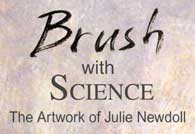

 View Portfolio |
 Inside Time |
 Shows |
 About/Contact the Artist |
Paintings from the Inside Time series:
A complete description of this series and its origins can be found in the "Inside Time" section of this web site. The explanations of the paintings describe the scientific basis for the initial inspiration of the painting. The characteristics of these proteins are discussed further in "Inside Time".
Bax Twins Delivering Death, 33" x 44", 1999.
Available for purchase.Prints available
If a cell is given a signal that it should kill itself, BAX is one of the proteins that accomplishes this task. Normally, this protein floats around in the cell as a lingering ghost, not disturbing anything, but waiting for the cell to receive a death signal. Once this signal is received, such as when a cell suffers injury or poisoning, or perhaps has gotten too old to function, this protein pairs up in twos (dimers). Together, a pair inserts itself into the mitochondrial membrane, and basically "pops" the energy-making factory of the cell, causing it to die. This is part of the apoptosis mechanism of cell death.
Apoptosis is a necessary process for life as well as death. Folklore sometimes uses the flickering candle to represent death. It is a part of the cycle of life that ultimately generates new life.
Inspired in part by the papers "BCL-2 family members and the mitochondria in apoptosis", Aton Gross, James McDonnell, Stanley Korsmeyer, Genes and Development, 13:1899-911, 1999. Also by "La Calavera (Godmother Death)" by Clarissa Pinkola Estes, Ph.D.
Woman Contemplating the Increasing Speed of her Biological Clock: 33" x 44", 1999, Private Collection
A woman is born with thousands of eggs (oocytes) at birth. During her lifetime, she will ovulate only about 400 eggs. The rest of these eggs seem to self-destruct via the mechanism of apoptosis, or programmed cell death. What causes these eggs to die? If they died at a constant rate until menopause, a woman would be losing two eggs a minute. It seems, however, that we lose fewer eggs during the early part of our life, and this egg loss gets faster and faster as a woman ages. The oocyte in the background is like a waning moon. Egg loss has reached the tenth hour of her biological clock.
Inspired in part by the paper "Oocyte Apoptosis: Like Sand through an Hourglass", Yutaka Morita and Jonathan Tilly, Developmental Biology 213, 1-17, 1999. Figure originally in "Prolongation of ovarian lifespan..." by Perez et. al, Nature Genetics. vol21 #2, 1999. Special thanks to Chris Gralapp.
Greek Tragedy and the Life and Death of the Cell*: 4' x 5', 1997. Available for purchase.Prints available $9,500, unframed.
Necrobiology is the study of cell death. Apoptosis is one mechanism of cell death dealt with in the "Inside Time" series. In the study of cell death, cells commit murder, suicide, incur accidental death, and sacrifice themselves for
the good of the community of cells. This sounded so much like a Greek tragedy to me, I could not help juxtaposing the two. This painting portrays a key character in the origins of Greek Tragedy , Dionysis, and some characters that are related to him, Hades, Persephone, and Demeter, whom all have cyclic lives. Four stages in the cycle of a cell are stamped on the four characters. They are seen through a screen of apoptotic cells (cells undergoing cell death).
*Formerly titled "Greek Tragedy through Necrobiology". Inspired in part by the paper "Detection of Apoptosis and DNA Replication by Differential Labeling of DNA Strand Breaks with Fluorochromes of Different Color", Xun Li, Myron R. Melamed and Zbigniew Darzynkiewicz, Experimental Cell Research 222, 28-37 (1996). Special thanks to Dr. Darzynkiewicz.
Watching the Clock Gene: Woman Reclining near the Suprachiasmatic Nucleus: 33" x 44", 2000. Available for purchase.
The Circadian Rhythm, the clock inside our head that dictates our daily cycle, is controlled mainly in a place inside the brain called the Suprachiasmatic Nucleus. Genes such as the Clock gene reside in this area, and in the back of the eye. Light trains this clock. It is regulated by the buildup and breakdown of proteins during the day and night. We are quickly discovering the means for controlling our Circadian Clock.
Inspired in part by the paper "Functional Identification of the Mouse Circadian Clock Gene by Transgenic BAC Rescue,Marina P. Antoch, et. al., Cell, Vol. 89, 655-667, May 16, 1997.
Apoptosis Queen: 33" x 44", 2000. Available for purchase.Prints available
$5000 with handmade walnut frame.
The Apoptosis queen holds a piece of protein in her left hand called BH3, which is most likely necessary in all pro-apoptotic proteins involved in the organelle destruction pathway of apoptosis. Her hair reflects the shape of the apoptotic protein BID, which is part of this group of proteins. See close up.
Inspired in part by the papers "BCL-2 family members and the mitochondria in apoptosis", Aton Gross, James McDonnell, Stanley Korsmeyer, Genes and Development, 13:1899-911, 1999, and by "Analysis of Apoptosis by Laser Scanning Cytometry, Bedner E; Li X; Gorczyca W; Melamed MR; Darzynkiewicz Z, Cytometry 35:1810195, 1999.
Voyage With One's Self: 3' x 4', 1997. Available for purchase.Prints available:
A dream of time travel with one's self . Just a dream.